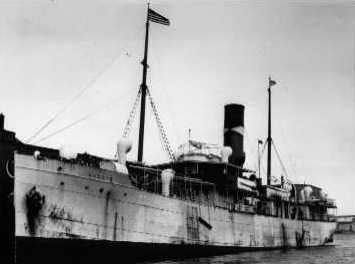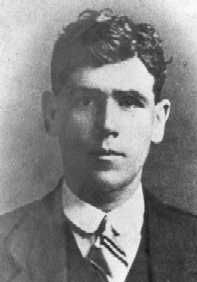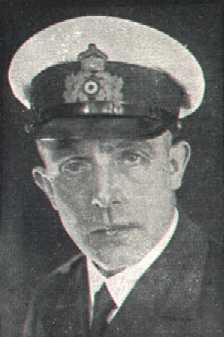Aye Aye Aylevarroo
The Search for Jack Lawlor
By John Early, July 1999
 When I was a little boy, my mother told me of her father, my
grandfather, Jack Lawlor. She had never known him, as he had been lost at sea when she was
only six months old. All that the family had ever learned of his death was that Jack had
sailed from Liverpool on the merchant steamship Aylevarroo in the autumn of 1917
and that the ship had never reached the end of her voyage. Rumour had it that she was
overloaded and had foundered in a storm. A month after the disappearance the Aylevarroo
was posted as overdue. A year later Jack was officially declared missing, presumed lost at
sea. He was twenty one years old.
When I was a little boy, my mother told me of her father, my
grandfather, Jack Lawlor. She had never known him, as he had been lost at sea when she was
only six months old. All that the family had ever learned of his death was that Jack had
sailed from Liverpool on the merchant steamship Aylevarroo in the autumn of 1917
and that the ship had never reached the end of her voyage. Rumour had it that she was
overloaded and had foundered in a storm. A month after the disappearance the Aylevarroo
was posted as overdue. A year later Jack was officially declared missing, presumed lost at
sea. He was twenty one years old.
His widow, Mary Jane, refused to believe that he had died and waited
for him for fourteen years before she married Jim Moonan, another sailor. She died in
Liverpool in 1960 at the age of sixty six.
But what of Jack? What had happened to him, his ship and the rest of
the crew? Family tales plus searches through museums and libraries as well as British and
German naval records led to the answer.
Jack had been born in Clonmellon, County Westmeath in Ireland in 1896.
His mother was born Kate Lynagh and he had two older brothers, Christy and Bobby, and a
sister Maisey. In that year Carl Siegfried Ritter von Georg, the man whose actions would
later kill Jack, was ten years old.
When Jack was a seven year old boy in 1903, the Tyneside shipyard of CS
Swan & Hunter Ltd. built a steamship of a modern design with triple-expansion steam
engines capable of ten knots. The ship was originally registered in Bristol as the Lillie
and owned the Donald Steamship Company Inc. of New York. Later she was purchased by the
Limerick Steamship Company Ltd. of Ireland and re-registered in Limerick as the Aylevarroo.
Jack was eighteen years old when the United Kingdom of Great Britain
and Ireland declared war on the German Empire in the August of 1914. He had already left
home and was living in lodgings in Drogheda, County Louth, where he worked as a labourer.
There he met Mary Jane Quigley at a village dance and the two fell in love and married.
Jack moved into the family home in Windmill Lane where Mary Jane lived with her mother
Ellen, her father Owen and her elder brother Jimmy. Jimmy soon enlisted with the British
Army to fight against the Germans in France. He was shelled, gassed, blown-up and shot
during his time on the battlefield. After the war he had many exciting tales of adventure
to tell, but the family always jokingly called him 'a bloody liar'. He emigrated to
America where he worked for many years as a taxi driver in New York.
Drogheda is a seaport and Jack found work on the ships. In 1916, he and
Mary Jane moved to Liverpool to earn money for their own home. They moved into lodgings in
Dublin Street near Liverpool's north docks. In July of the same year the Imperial German
Navy commissioned U-boat U-57.
In February 1917, Mary Jane presented Jack with a baby daughter,
Kathleen, my mother. Kathleen was born in Drogheda because Mary Jane's own mother, Ellen,
had ordered her back to Ireland for the birth. She didn't want any 'English' in the
family. In that same February, Germany's Chancellor Bethmann-Hollweg declared unrestricted
U-boat warfare. Mary Jane returned to Liverpool with baby Kathleen and the family took up
new lodgings in Fountains Road.
In October 1917, the Aylevarroo's master John Tracey, from
Rosses Point in Ireland, was preparing to sail from Liverpool to Tralee, then to Limerick
with a general cargo. Jack was employed as a fireman-stoker on the ship. Captain Tracey
was short of an able bodied seaman and cabled his friend, Thomas Devaney, in Rosses Point
asking him to join the ship's company. Thomas accepted and left for Sligo, intending to
catch the afternoon train to Dublin then the night boat to Liverpool. In Sligo he met an
old shipmate and the two went for a drink in a pub. Time slipped by and Thomas missed the
train, the ferry to Liverpool and the Aylevarroo.
On the evening the Aylevarroo was to sail, Jack said goodbye to
Mary Jane and his six-month-old daughter and left their home to join the ship. On the way
he met a fellow shipmate, also on his way to join the vessel. The two decided that there
was plenty of time for a drink before sailing and so dropped into a suitable pub.
Eventually they emerged. Jack was fine, but his friend had overdone it and was too drunk
or sick or both to go on and so went home instead. Like Thomas he too missed the sailing.
However, Jack reported for duty in the engine room. The Aylevarroo left Liverpool
at midnight on the evening of 6th October 1917.
 German U-boat U-57 was on patrol in the Atlantic off the
south coast of Ireland. The craft was carrying eight torpedoes, each nearly twenty foot
long and with a warhead equipped to penetrate the hull of a warship. Kapitšnleutnant
Georg was now thirty-one years old and commander of the submarine.
German U-boat U-57 was on patrol in the Atlantic off the
south coast of Ireland. The craft was carrying eight torpedoes, each nearly twenty foot
long and with a warhead equipped to penetrate the hull of a warship. Kapitšnleutnant
Georg was now thirty-one years old and commander of the submarine.
The Aylevarroo sailed out into Liverpool Bay and, after clearing
Holyhead, headed south through the Irish Sea then westward into the Atlantic after passing
Wexford. Nearing Cork on the southern coast of Ireland she was intercepted by the U-57.
The merchantman, sailing under a British flag, was considered to be a legitimate target
and open to hostile action.
At nine knots the submerged U-57 was marginally slower than the
ten knots of its prey. However, this difference was more than accommodated for by the
twenty-seven knots of the C 06 AV torpedo fired against the target. The torpedo
breached the hull of the Aylevarroo and the two hundred and seventy pound warhead
exploded.
The Aylevarroo and her twenty crew, including the ship's master,
were lost off the Ballycotton Islands near Cork on 8th October 1917. On 21st November
1917, Lloyds recorded the ship as 'missing, presumed by the Admiralty to have been sunk by
submarine'.
The Limerick Steamship Company Ltd. had previously lost three other
ships to U-boat action; the Oola to U-56 in October 1916, the Coonagh
to UC-16 in March 1917 and the Islandmore to U -33 in June 1917.
As for the U-57, she sunk fifty five ships for a total of 91,680
tons and one warship, HMS Genista, at 1,250 tons. Her greatest success was the
sinking of the British vessel Rovanmore, at 10,320 tons, in October 1916. The
submarine survived the war and was scrapped in Cherbourg in 1921.
Kaptlt Georg later received the highest German war decoration, the Pour
le Merite (the Blue Max), as the commander of U-101. He died in 1957 at the age
of seventy one.
The end of Jack and the Aylevarroo? Well, almost but not quite.
In 1990 my search took me to Aylevarroo (the place) in County Clare and
then to Clonmellon, my grandfather's birthplace. My mother had last visited Jack's mother
in 1939, just before the outbreak of the Second World War. She told me that the old lady
had a large photographic portrait of Jack hanging on the wall of her bedroom. It had been
taken just two months before he was killed and she loved it dearly. She gave my mother a
miniature of the portrait to keep. Jack's mother died in 1940 and his brothers and sister
had long since died by the time I got there. All traces of the Lawlors seemed to have
gone.
I was about to leave Clonmellon when by chance I met an elderly lady
who turned out to be the daughter of Jack's sister Maisey. Her name was Maisey too. She
gave me all the gossip that had been hidden for so long and took me to where the family
home had been. The house was there, now much renovated by new owners, but all of the
family's things had gone. All of the personal stuff had been burned on a bonfire years
before. All except for one item. Maisey took me to an old caravan that was being used as a
farm store and chicken shed. She rummaged around and presented me with a parcel wrapped in
string and dirty newspapers dated 1962. I was told that my great grandmother had always
loved 'this' so much that nobody could throw it away. That 'they' knew that one day I
would come for it and now I must take it away with me. I opened the parcel and saw Jack
Lawlor's face looking back at me. It was the portrait, lost for half a century.
Altogether, a satisfactory conclusion to the day's work.
Jack's portrait now hangs on the wall in the home of his daughter
Kathleen. Copies hang in other homes including mine, where Jack can look down on his three
great grandchildren, Catriona, Tara and James. There is one problem though. They were born
in England. Whatever would Ellen Quigley say now that there are 'English' in the family?
And the Aylevarroo? There's a lot more to that ship yet, but
that's a tale for another day.

 When I was a little boy, my mother told me of her father, my
grandfather, Jack Lawlor. She had never known him, as he had been lost at sea when she was
only six months old. All that the family had ever learned of his death was that Jack had
sailed from Liverpool on the merchant steamship Aylevarroo in the autumn of 1917
and that the ship had never reached the end of her voyage. Rumour had it that she was
overloaded and had foundered in a storm. A month after the disappearance the Aylevarroo
was posted as overdue. A year later Jack was officially declared missing, presumed lost at
sea. He was twenty one years old.
When I was a little boy, my mother told me of her father, my
grandfather, Jack Lawlor. She had never known him, as he had been lost at sea when she was
only six months old. All that the family had ever learned of his death was that Jack had
sailed from Liverpool on the merchant steamship Aylevarroo in the autumn of 1917
and that the ship had never reached the end of her voyage. Rumour had it that she was
overloaded and had foundered in a storm. A month after the disappearance the Aylevarroo
was posted as overdue. A year later Jack was officially declared missing, presumed lost at
sea. He was twenty one years old.
